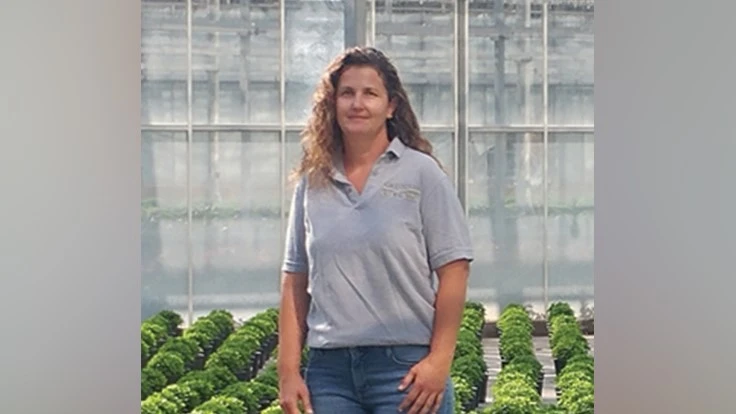

Julie Iferd has been a “tree hugger and nature lover” for as long as she can remember. After growing up on a dairy farm in South Dakota, she studied natural resource management at the University of Alaska Fairbanks, with plans to work in park service. But as soon as she took a horticulture class, she found her true passion for plants inside the greenhouse — and promptly changed her major.
“I just enjoy growing flowers. It suited me better than the other classes I was taking,” says Iferd, who finished her horticulture degree at the University of Minnesota in 2002, while working for a local garden center.
Now, instead of hugging trees, Iferd concentrates on growing flowers. She oversees the production of annuals, perennials, mums and poinsettias at Catoctin Mountain Growers in Keymar, Maryland, which serves customers like Walmart, Sam’s Club and several grocery chains and landscapers.
“I enjoy growing large quantities of great-looking product,” says Iferd, who began working as a section grower at Catoctin right after college and advanced to the role of head grower a few years later. “When I can look over acres of finished material that looks fantastic, it makes me happy and proud. It’s wonderful to work in this industry with genuinely good people who share a passion for plants.”

Continuing education
As head grower at Catoctin Mountain Growers, Iferd manages 17 acres under glass and 15 acres of outdoor production. Her growing team consists of four section growers, with the support of summer interns and assistance from the production staff. One of Iferd’s priorities is maintaining open lines of communication with the entire team to keep them all focused on plant health.
“The section growers are the ones with the most ‘touches’ on the plant. They decide every day whether to water and how much to water — which, to be honest, can have the most impact on the end quality of the product,” Iferd says. “So they need to be trained to make the right choice every day. This starts with knowing the needs and the potential problems of all the different plants we grow.”At the beginning of the week, Iferd walks the entire crop with her section growers to evaluate their priorities for the week. Any time a new crop enters a grower’s section, Iferd goes over the plant’s basic requirements, watering preferences and potential pitfalls like certain pests or diseases to watch out for. She advises them on how to monitor and identify specific issues throughout the year, and she takes careful notes of any issues they report. Since some of her growers have been at Catoctin Mountain Growers for 15 years, they bring a lot of experience and knowledge to each growing season, which benefits the overall operation.
Besides maintaining an ongoing dialogue with growers about the issues they’re seeing day to day, Iferd also encourages continuing education. When possible, she sends growers to industry events like Cultivate, MANTS and Chesapeake Green, the Maryland Nursery Landscape and Greenhouse Association’s annual symposium. Several breeders and suppliers also offer training to keep her team on the leading edge.
“It’s important to keep them growing and passionate about what they do,” Iferd says.

Optimizing efficiency
Finding labor is an increasing challenge at many greenhouses, including Catoctin Mountain Growers. So Iferd and her team work to optimize efficiencies by streamlining each step of the production process.
“Profit margins are always shrinking because costs are always rising,” Iferd says. “So we focus on producing quality crops with a focus on reducing costs. We look at our production methods and see how those can be improved to save money, time and labor.”
It starts with “picking good genetics that can save time by growing quickly or have the right growth habit to reduce plant growth regulators,” says Iferd, who helps select and trial new plant varieties. “The right genetics can save labor by not needing to be pinched, or they can have disease resistance, which saves money on chemicals.”
Profit margins are always shrinking because costs are always rising,” Iferd says. “So we focus on producing quality crops with a focus on reducing costs.”
One notable labor-saving decision at Catoctin Mountain Growers has been sticking unrooted cuttings directly into final containers, which eliminates the step of transplanting liners.
“When you direct stick, it takes a lot more space because the final container is much larger than the plug trays,” Iferd says. “Because it takes up so much space, all of the growers get a hand in propagating, as opposed to having one person propagating all the liners. This makes all of our growers better propagators and significantly reduces our hours by saving labor through the spring. It improves plant quality as well, and generally reduces overall production time.”
With a creative approach to streamlining the growing operation, combined with continuous training and education initiatives, Iferd amplifies her team’s abilities to produce plant material that meets the company’s high standards.

Explore the September 2019 Issue
Check out more from this issue and find your next story to read.
Latest from Greenhouse Management
- Happy holidays from the GIE Media Horticulture Group!
- North Carolina Nursery & Landscape Association announces new executive vice president
- Plant Development Services, Inc. unveils plant varieties debuting in 2025
- Promo kit available to celebrate first National Wave Day on May 3
- Applications now open for American Floral Endowment graduate scholarships
- Endless Summer Hydrangeas celebrates 20 years with community plantings
- Invest in silver
- Garden Center magazine announces dates for 2025 Garden Center Conference & Expo





